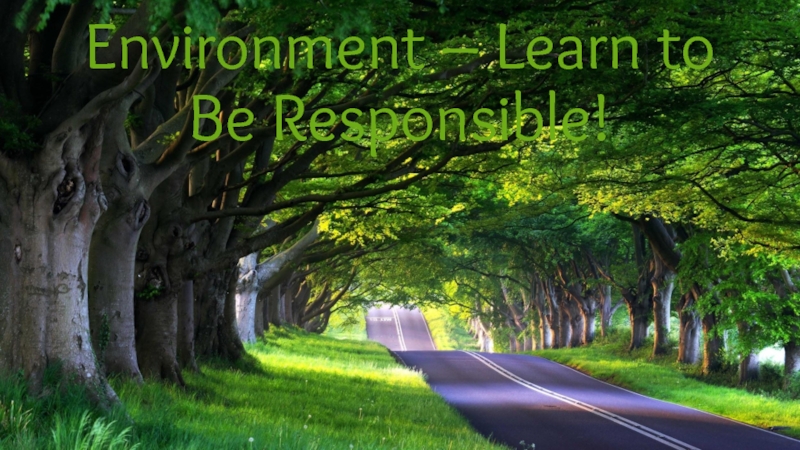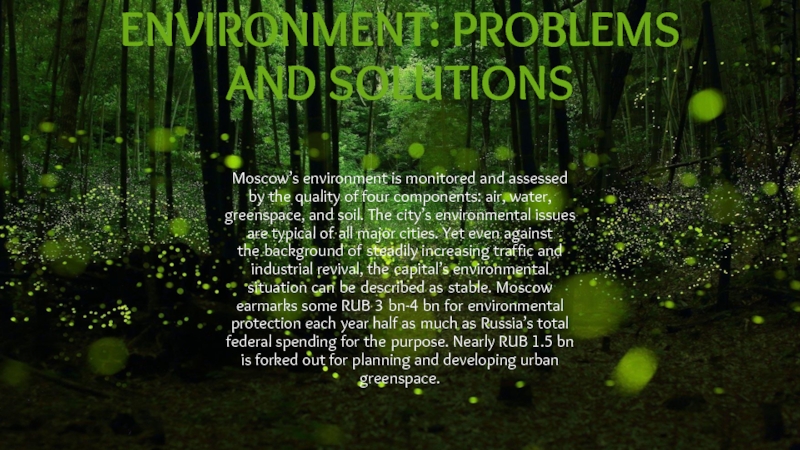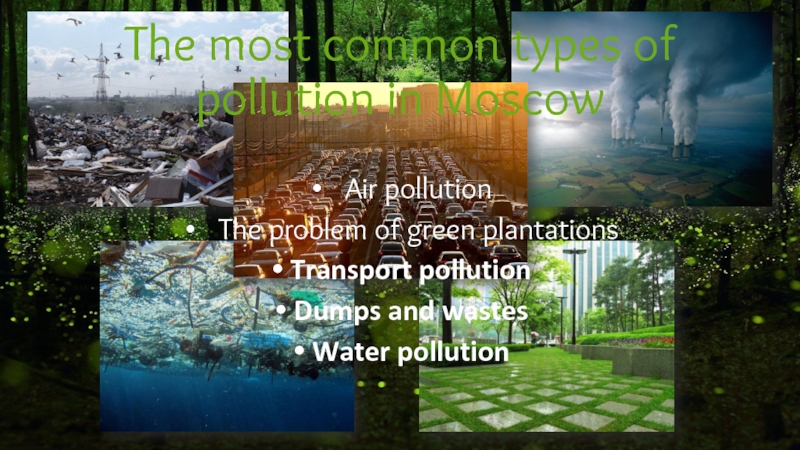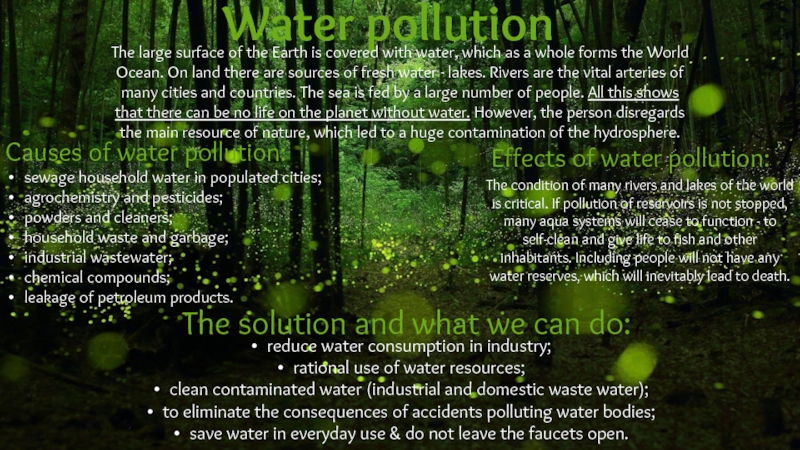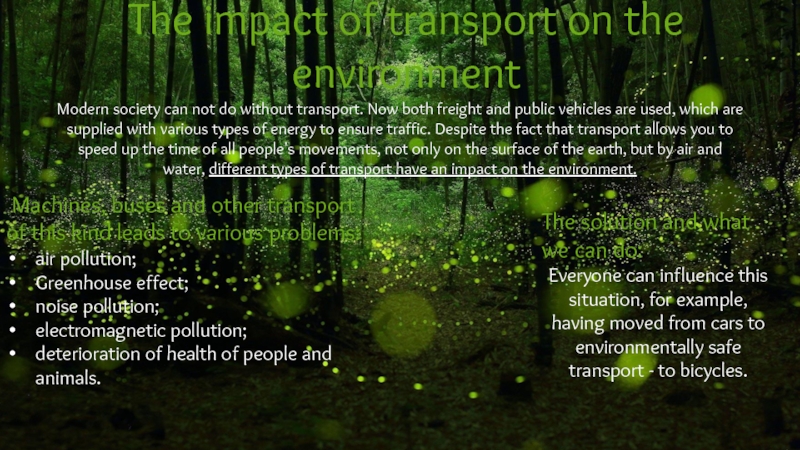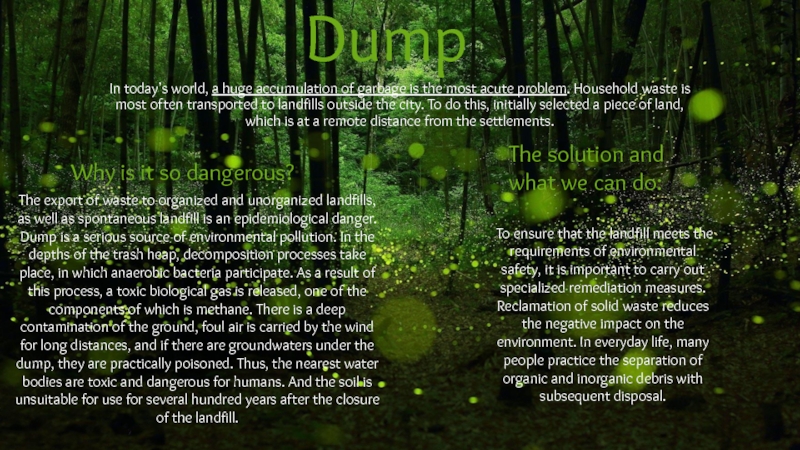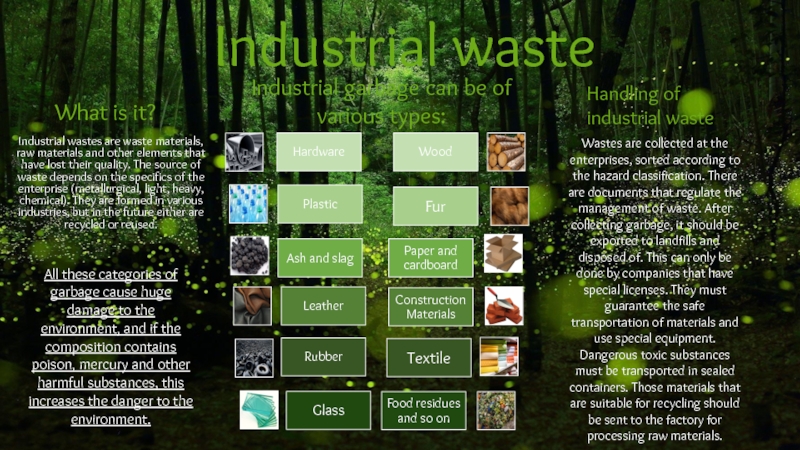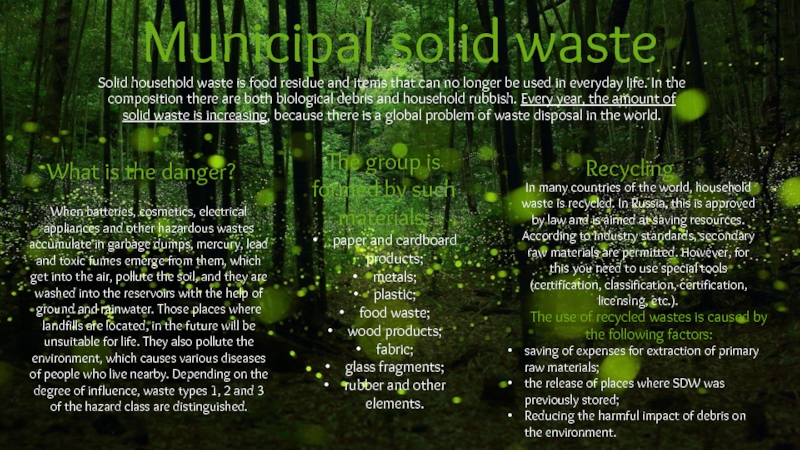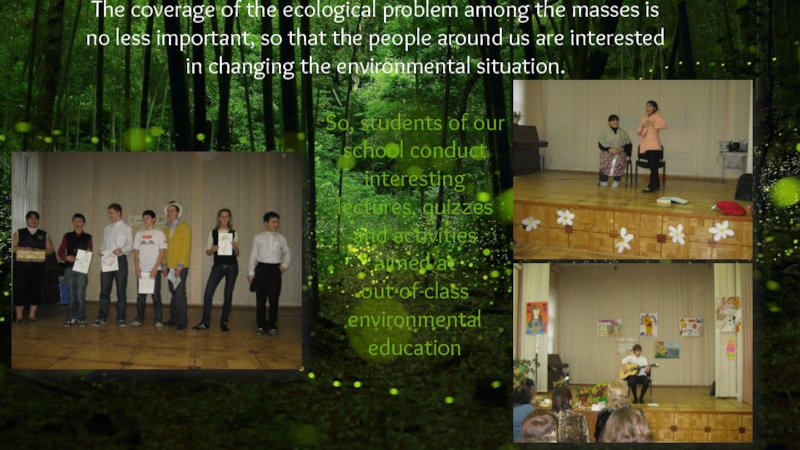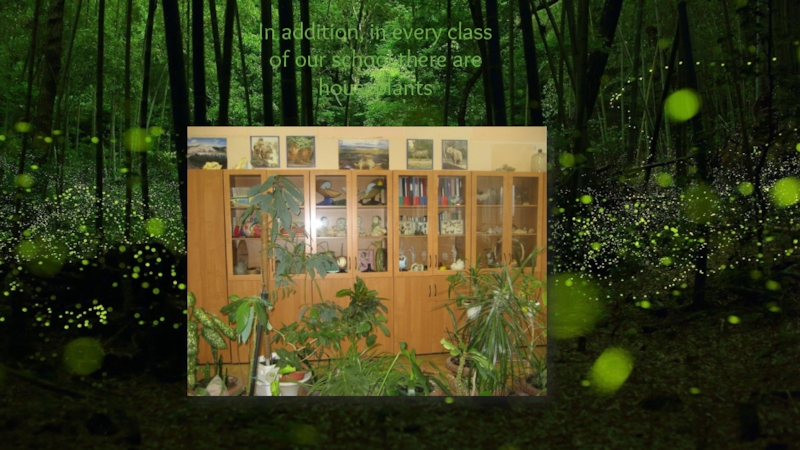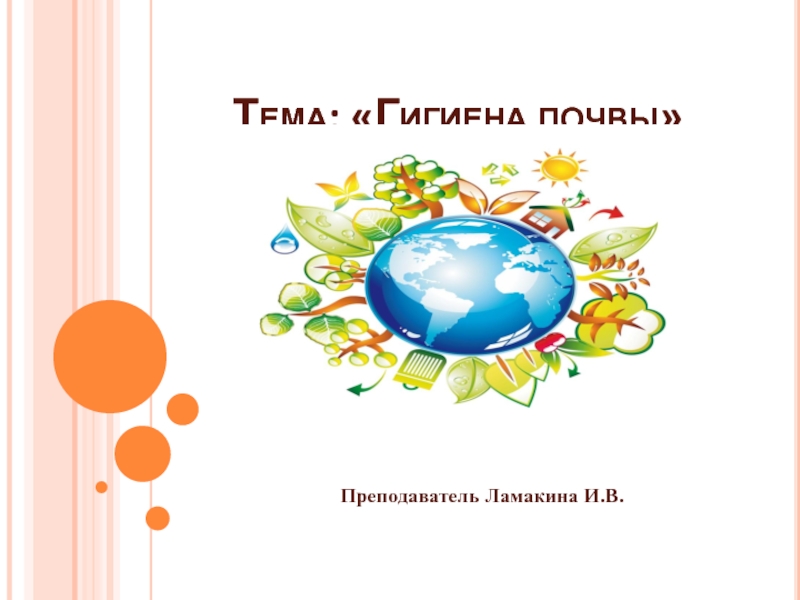- Главная
- Разное
- Дизайн
- Бизнес и предпринимательство
- Аналитика
- Образование
- Развлечения
- Красота и здоровье
- Финансы
- Государство
- Путешествия
- Спорт
- Недвижимость
- Армия
- Графика
- Культурология
- Еда и кулинария
- Лингвистика
- Английский язык
- Астрономия
- Алгебра
- Биология
- География
- Детские презентации
- Информатика
- История
- Литература
- Маркетинг
- Математика
- Медицина
- Менеджмент
- Музыка
- МХК
- Немецкий язык
- ОБЖ
- Обществознание
- Окружающий мир
- Педагогика
- Русский язык
- Технология
- Физика
- Философия
- Химия
- Шаблоны, картинки для презентаций
- Экология
- Экономика
- Юриспруденция
Environment – Learn to Be Responsible! презентация
Содержание
- 1. Environment – Learn to Be Responsible!
- 2. Moscow’s environment is monitored and assessed by the
- 3. The most common types of pollution in
- 4. Air is the most important wealth of
- 5. Water pollution The large surface
- 6. The impact of transport on
- 7. The problem of green plantations The problem
- 8. Dump In today's world, a huge accumulation
- 9. Industrial waste Industrial wastes are waste materials,
- 10. Municipal solid waste Solid household waste is
- 11. Recycling of garbage Industrial and household waste
- 12. Rational use of natural resources On our
- 13. In our school Students and teachers of
- 14. The coverage of the ecological
- 15. In addition, in every class of our school there are houseplants
- 16. The end
Слайд 2Moscow’s environment is monitored and assessed by the quality of four components:
ENVIRONMENT: PROBLEMS AND SOLUTIONS
Слайд 3The most common types of pollution in Moscow
Air pollution
The problem of
Transport pollution
Dumps and wastes
Water pollution
Слайд 4Air is the most important wealth of the planet, but people
Air Pollution
Causes of air pollution:
emissions and activities of industrial facilities;
car exhausts;
radioactive objects;
domestic and industrial wastes.
Effects of air pollution:
health problems;
smog in large cities;
Greenhouse effect;
global warming & climate change;
precipitation of acid rain.
The solution and what we can do:
To do this, reduce the use of vehicles, reduce waste, use environmentally friendly technologies and switch to renewable energy sources.
Слайд 5
Water pollution
The large surface of the Earth is covered with water,
Causes of water pollution:
sewage household water in populated cities;
agrochemistry and pesticides;
powders and cleaners;
household waste and garbage;
industrial wastewater;
chemical compounds;
leakage of petroleum products.
Effects of water pollution:
The solution and what we can do:
reduce water consumption in industry;
rational use of water resources;
clean contaminated water (industrial and domestic waste water);
to eliminate the consequences of accidents polluting water bodies;
save water in everyday use & do not leave the faucets open.
The condition of many rivers and lakes of the world is critical. If pollution of reservoirs is not stopped, many aqua systems will cease to function - to self-clean and give life to fish and other inhabitants. Including people will not have any water reserves, which will inevitably lead to death.
Слайд 6
The impact of transport on the environment
Modern society can not do
Machines, buses and other transport of this kind leads to various problems:
air pollution;
Greenhouse effect;
noise pollution;
electromagnetic pollution;
deterioration of health of people and animals.
The solution and what we can do:
Everyone can influence this situation, for example, having moved from cars to environmentally safe transport - to bicycles.
Слайд 7The problem of green plantations
The problem of "green spaces" is one
With the growth of the city, the development of its industry is becoming increasingly difficult to protect the environment, creating normal conditions for life and human activities. The intensive development of industry and agriculture is accompanied by significant disruptions in the properties of the natural environment surrounding man. As it develops, the city grows and expands. In general, the increase in the city's territories is due to deforestation.
The main functions of green plantations:
Sanitary and hygienic.
Recreational.
Structural and planning.
Decorative and artistic.
Mandatory requirements for the system of gardening are uniformity and continuity. The main elements of the city greening system are parks, gardens, green areas of residential and industrial areas, embankments, boulevards, squares, protective zones.
People make the wrong choice, destroying whole forest tracts. Without trees on the planet, not only thousands of species of fauna will die, but also the people themselves, because they suffocate from dirty air, which there will be no one else to clean. Therefore, we must protect nature, not to destroy trees, but to plant new ones to somehow reduce the damage caused by the human environment.
Слайд 8Dump
In today's world, a huge accumulation of garbage is the most
The export of waste to organized and unorganized landfills, as well as spontaneous landfill is an epidemiological danger. Dump is a serious source of environmental pollution. In the depths of the trash heap, decomposition processes take place, in which anaerobic bacteria participate. As a result of this process, a toxic biological gas is released, one of the components of which is methane. There is a deep contamination of the ground, foul air is carried by the wind for long distances, and if there are groundwaters under the dump, they are practically poisoned. Thus, the nearest water bodies are toxic and dangerous for humans. And the soil is unsuitable for use for several hundred years after the closure of the landfill.
To ensure that the landfill meets the requirements of environmental safety, it is important to carry out specialized remediation measures. Reclamation of solid waste reduces the negative impact on the environment. In everyday life, many people practice the separation of organic and inorganic debris with subsequent disposal.
The solution and what we can do:
Why is it so dangerous?
Слайд 9Industrial waste
Industrial wastes are waste materials, raw materials and other elements
What is it?
All these categories of garbage cause huge damage to the environment, and if the composition contains poison, mercury and other harmful substances, this increases the danger to the environment.
Industrial garbage can be of various types:
Handling of industrial waste
Wastes are collected at the enterprises, sorted according to the hazard classification. There are documents that regulate the management of waste. After collecting garbage, it should be exported to landfills and disposed of. This can only be done by companies that have special licenses. They must guarantee the safe transportation of materials and use special equipment. Dangerous toxic substances must be transported in sealed containers. Those materials that are suitable for recycling should be sent to the factory for processing raw materials.
Слайд 10Municipal solid waste
Solid household waste is food residue and items that
The group is formed by such materials:
paper and cardboard products;
metals;
plastic;
food waste;
wood products;
fabric;
glass fragments;
rubber and other elements.
When batteries, cosmetics, electrical appliances and other hazardous wastes accumulate in garbage dumps, mercury, lead and toxic fumes emerge from them, which get into the air, pollute the soil, and they are washed into the reservoirs with the help of ground and rainwater. Those places where landfills are located, in the future will be unsuitable for life. They also pollute the environment, which causes various diseases of people who live nearby. Depending on the degree of influence, waste types 1, 2 and 3 of the hazard class are distinguished.
What is the danger?
Recycling
In many countries of the world, household waste is recycled. In Russia, this is approved by law and is aimed at saving resources. According to industry standards, secondary raw materials are permitted. However, for this you need to use special tools (certification, classification, certification, licensing, etc.).
The use of recycled wastes is caused by the following factors:
saving of expenses for extraction of primary raw materials;
the release of places where SDW was previously stored;
Reducing the harmful impact of debris on the environment.
Слайд 11Recycling of garbage
Industrial and household waste is the main waste that
Garbage collection
Various types of waste and garbage are collected in special tanks installed near all residential buildings and public buildings, as well as in street urns. Recently, garbage sorters for certain types of waste have been used:
glass;
paper and cardboard;
plastic waste;
other types of garbage.
The use of tanks with the separation of garbage into species is the first stage of its utilization. So it will be easier for employees to sort it out in garbage dumps. In the future, some types of waste are sent for recycling, for example, paper and glass. The remaining types of waste are sent to landfills and to burial sites.
In order not to drown in the garbage, humanity should think about solving the problem of garbage disposal and radically change the actions aimed at neutralizing waste. It can be recycled. Although this will take a lot of finance, but there will be a chance to invent alternative sources of energy.
Слайд 12Rational use of natural resources
On our planet there is a large
The main activities of rational use of nature
it is necessary to reduce its interference in nature;
as less as possible to use natural resources without the need;
protect nature from pollution (do not drain pollutants into water and soil, do not litter);
to abandon cars in favor of environmental transport (bicycles);
save water, electricity, gas;
to refuse disposable adaptations and goods;
to benefit society and nature (grow plants, make rational inventions, use eco-technologies).
Ecological principles of resource use
In the era of not just scientific and technological progress, but in the post-industrial era, environmental protection is of particular importance, since in the course of development people actively influence nature. This leads to excessive use of natural resources, pollution of the biosphere and climate change.
In order to preserve the integrity of the biosphere, several conditions are necessary:
taking into account the laws of nature;
protection and protection of the environment;
rational consumption of resources.
Слайд 13In our school
Students and teachers of our school are concerned about
One such example is the cleaning of the area around the school in the fall and spring
Слайд 14
The coverage of the ecological problem among the masses is no
So, students of our school conduct interesting lectures, quizzes and activities aimed at out-of-class environmental education
